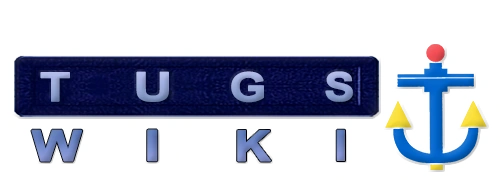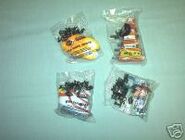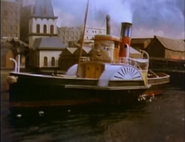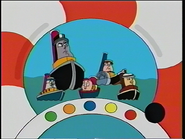
Salty's Lighthouse is a television series created by Nina I. Hahn and produced by Sunbow Entertainment for TLC (which featured it on their Ready Set Learn block). Produced for a single season of forty ten-minute episodes, it was first broadcast in 1997 (running in tandem with various PBS stations) and ended in 1998. The show featured cartoon animated segments of a boy named Salty with his animal friends in a lighthouse, as well as live-action segments made from edited and re-dubbed TUGS footage.
Music for the series was composed by Chase Rucker Productions. The series was also produced in association with the Bank Street College of Education, New York.
The series is currently in ownership of Sony Music in the US and Canada and Studio100 in the rest of the world.
Characters
- Salty - The main character who loves using his imagination to commiserate with human and animal friends alike, learning all sorts of lessons.
- Ocho - Salty's octopus friend.
- Claude - Salty's crab friend.
- Sophie and Sadie - Two girl seagulls.
- Aunt Chovie - Salty's aunt who owns the lighthouse.
- Aurora - A talking lightbulb at the top of the lighthouse who narrates the TUGS segments.
- Seymour - A pair of binoculars who helps the group watch the tugs.
- The Clams - Five clams who always have fun.
- The Clock - A yellow-faced clock that announces the Salty's Song Time segments that are sung by some of the cast and featured clips from old Black & White films some of which were from Charlie Chaplin and included specially added animation for some scenes in the songs.
Episode List
- Mixed Signals (October 3, 1997)
- Too Young to Be Included (October 10, 1997)
- Taking Off (October 17, 1997)
- Let's Party! (October 24, 1997)
- Blackout (October 31, 1997)
- Eight is Too Much (November 7, 1997)
- One Bad Day (November 14, 1997)
- Hands Off! (November 21, 1997)
- Salty Come Lately (November 28, 1997)
- It's Magic (December 5, 1997)
- Count on Me (December 12, 1997)
- Knot So Nice (December 19, 1997)
- Taking My Turn (December 26, 1997)
- Backward Day (January 2, 1998)
- Banana Splits (January 9, 1998)
- Clear the Decks (January 16, 1998)
- Claude in Charge (January 23, 1998)
- The Favorite (January 30, 1998)
- Strike Up the Band (February 6, 1998)
- Blankety Blank (February 13, 1998)
- Last of the Red Hot C Gulls (February 20, 1998)
- Farley Frog (February 27, 1998)
- Boss Man (March 6, 1998)
- Sophie Come Home (March 13, 1998)
- Who Took My Crayons? (March 20, 1998)
- High Spirits (March 27, 1998)
- Some Guys Have all the Luck (April 3, 1998)
- Dream On (April 10, 1998)
- Sound Off (April 17, 1998)
- Treasure Hunt (April 24, 1998)
- Who Turned Off the Lights? (May 1, 1998)
- If the Clue Fits, Wear It (May 8, 1998)
- Desperately Seeking Sadie (May 14, 1998)
- Colossal Crab (May 15, 1998)
- The Big Birthday Splash (May 22, 1998)
- Stop the Music (May 29, 1998)
- Let's Wing It (June 5, 1998)
- No Strings Attached (June 12, 1998)
- Guilty Gull (June 19, 1998)
- Bivalve Blues (June 26, 1998)
Salty's Song Time List
- Don't Clam Up
- There's Always Another Game to Play
- Ask for Help
- Let's Party
- Whistling in the Dark
- Dressin' Up
- Turn it Around
- I'm Sorry
- Can I Play Too?
- It's Magic
- You Can Do It
- Imagining
- Make Your Own Music
- New to You
- Shake it Up
- We Can Do it Together
- Listen
- Let's Give a Cheer For Me
- I Love The Sound of a Band
- Let's Think of Something
- Your Turn
- Let's Get Silly Now
- See What we Made
- Busy Busy Busy
- Let's Think Back
- By My Side
Cast
Cartoon
- Rhys Huber as Salty
- Kathleen Barr as Ocho and Aunt Chovie
- Janyse Jaud as Sophie and Sadie
- Andrea Libman as Claude
TUGS
- Ian James Corlett as Ten Cents, Otis, Zeebee, Zip, Lord Stinker and Frank and Eddie
- Scott McNeil as Zorran, Zak, Zug, Bluenose and Boomer
- Paul Dobson as Big Stack, Hercules, Captain Zero, Izzy Gomez, Sea Rogue, Billy Shoepack, Cappy, Mr. Boffo and Mr. Socko, Tramper, Old Rusty, Scoop and Chooch
- Lenore Zann as Sunshine, Little Ditcher, Captain Star, Lillie Lightship and Sally Seaplane
- French Tickner as Top Hat, Warrior, Grampus, Steamer and Scuttlebutt Pete
Home Media Releases
In 1999, Salty's Lighthouse was released on the Video Buddy Interactive VHS format through Sony Wonder; three releases were made, making a total of six episodes released in the US and Canada. In addition to the episodes, they contained interactive segments and music videos.
On May 13, 2003, a VHS including six episodes was released in the UK by Maverick, and in 2005, a children's preschool compilation DVD named "Toddler Time" was released that included two episodes.
A DVD for the US was planned but it was scrapped shortly after the rights were lost.
The series was also briefly on the free streaming site "Kidobi", but the series as of now has been taken down due to lost rights.
All the episodes have been uploaded to YouTube by "Ziggyy Family Entertainment", a company owned by M4E.
Comparisons with TUGS
- Due to the limited footage the crew had from the original thirteen episodes, most of the TUGS segments often adapt a certain plotline taken from the original TUGS episodes like the tramper stuck on the rocks in Trapped, Top Hat's dilemma with the railway bridge in High Tide, or Sunshine getting stuck in the logs in Up River. These were rewritten to various degrees to be more suitable for a preschool audience, and in several cases, the existing footage was re-edited and dubbed into newly-written stories, relating to the moral lesson of the episode it featured in. As a result from different TUGS episodes being edited together, continuity errors are visible, including characters' barges differing in sequential scenes, Sunshine's model constantly changing from his original white paintwork to his yellow paintwork, smoke retreating back into stacks in reversed scenes, daylight scenes in night time scenes and sometimes the other way around, and abrupt weather changes.
- Bigg City Port is renamed Snugboat Harbour and set in the modern day (with more "90's" lingo, references to pop culture, and hip-hop being utilized), with the titular lighthouse being located in the harbour.
- The sound design was modernized, with the tugs gaining diesel engines and horns rather than steam engines and whistles (although some of the tugs like Ten Cents and Sunshine have steam whistles and O.J./Otis retains paddle steamer sounds). The soundtrack was also altered to include more typical children's series score instead of using the original music by Mike O'Donnell and Junior Campbell.
- Multiple impossible events occur, such as the tugboats using Captain Star's megaphone, the tugs willingly sinking themselves without any structural damage, and lifting sunken boats by pulling them horizontally to the surface using a small tow rope. This was due to the limit the crew seemed to have with the amount of live-action footage they had.
- The Star Fleet and the Z-Stacks, originally two rival fleets in TUGS, become friends in this show. This is mostly noticeable with Captain Zero not acting like a gang boss. However, the old rivalry is sometimes shown (mostly portrayed with Zorran).
- Sunshine, Captain Star, and Little Ditcher are portrayed as female characters. This was likely done for diversity reasons as TUGS had only a handful of female characters.
- Ten Cents and Sunshine are depicted as siblings.
- Sea Rogue is an actual pirate tug, is portrayed as a villain and exists only in Top Hat's dreams, differing from how he wasn't a real pirate, was only stealing for his uncle's safety and was a real tug originally.
- Captain Zero is given a personality that mirrors Captain Star's in some respects, although they're still portrayed as sometimes having a rivalry.
- While many characters in TUGS have varied British accents (such as Glaswegian, Cockney, South Welsh, British Midlands, Lancastrian, and Liverpudlian), in this series the characters have varied Northeastern American accents (such as Bronx, New Jersey, and Brooklyn).
- Their are several name changes to characters:
- Big Mac becomes Big Stack, possibly to avoid legal trouble with McDonald's over the name of their famous burger of the same name.
- O.J. becomes Otis, possibly to avoid confusion with O.J. Simpson, whose trial was still a hot-button topic at the time.
- The Coast Guard and his messenger are presented as the same character, Cappy.
- Zebedee becomes Zeebee. (This was originally thought so as to avoid contact with Zebedee from The Magic Roundabout, until it was pointed out that the original series of The Magic Roundabout isn't that very known in America, so it is most likely 100 percent estimated that it wasn't the case in the first place, even though both these 'Zebedee' characters do have moustaches, of course.) His original nameplate though is left uncovered, implying that his name was misinterpreted.
- Puffa is simply called the Train. He was also once called Chooch.
- Jack is renamed Scoop.
- The two scrap dealers, Burke and Blair become Mr. Boffo and Mr. Socko, and are portrayed as movie producers. Strangely, their original nameplates are left uncovered.
- Johnny Cuba becomes Steamer and Nantucket becomes Tramper (and a non-vocal character on ocassions) and are portrayed as friendly characters.
- The Fultan Ferry speaks in this show, despite not having a visible face or megaphone. She is also referred to as male. But in one episode she is her original gender and voiceless.
- The Quarry Master was named Stoney in one episode.
- Story elements were altered to be more preschool-friendly; some examples include the munitions being referred to as "explosives" or "fireworks", Izzy Gomez speaking with a more gravelly American accent as opposed to his more stereotypical Mexican accent, and many of the more violent or scary aspects of certain episodes being left unused (from Munitions for example; Big Mickey's fall into the water, the oil barge exploding, and Kraka-Toa's sinking, while in Ghosts, the scene with Neptune's Face was cut.).
Trivia
- Salty's Lighthouse stems from an earlier effort to bring the original TUGS to North America. This version, of which only a single test episode was produced, would have been a straightforward re-dub of the original show, rather than the edited stories used in Salty's Lighthouse.
- In Spain, the show was dubbed to Asturian Spanish and aired in Asturias in Northwest Spain, where it was known as El Faru D' Illán.
- In Poland, the show was dubbed to Polish and was known as "Latarnia Solusia".
- The show had the reels for only the 15 minute cuts and the 20 minute cut of Pirate. Shots exclusive to the other three 20 minute cuts are in lesser quality likely due to being ripped from VHS.
- Episodes were paired together when they aired on PBS and TLC in the USA.
- Most of the songs in the show can be seen in more than one episode after the twenty-sixth episode.
- Old Rusty appears twice and Warrior bumps into him twice.
- Robert D. Cardona is the only crew member involved in TUGS to receive credit for his work on TUGS in this series, while director David Mitton and all the others who were involved with the original series are not credited at all.
- Some characters from TUGS such as the Fire Tug, Sea Rogue's Uncle, Big Mickey, Mighty Mo and Pearl, either did not appear in Salty's Lighthouse with speaking roles or at all (although Mighty Mo is mentioned by name in an episode not involving him).
- In 1999 Salty's lighthouse was mentioned in the book "The Encyclopedia Of Animated Cartoons Second Edition".
- Despite using animation for the lighthouse scenes, as well as edited footage of TUGS, original storylines, edited names and genders for some of the TUGS characters, the Salty's Lighthouse show shares some similar features to Shining Time Station, the show that introduced American audiences to Thomas the Tank Engine:
- Both shows have music videos using clips of old films. [Cartoons with Shining Time Station, Silent Black & White Live Action films with Salty's Lighthouse].
- Both shows begin their segments with a character announcing their beginning [Seymour the pair of binoculars or Aurora the lightbulb in some episodes in Salty's Lighthouse and Mr. Conductor in Shining Time Station.]
References
- m4e's Website
- Kidobi's Page for Salty's Lighthouse
- Toddler Time DVD
- UK VHS Release
- Salty's Lighthouse FANDOM
Gallery

































